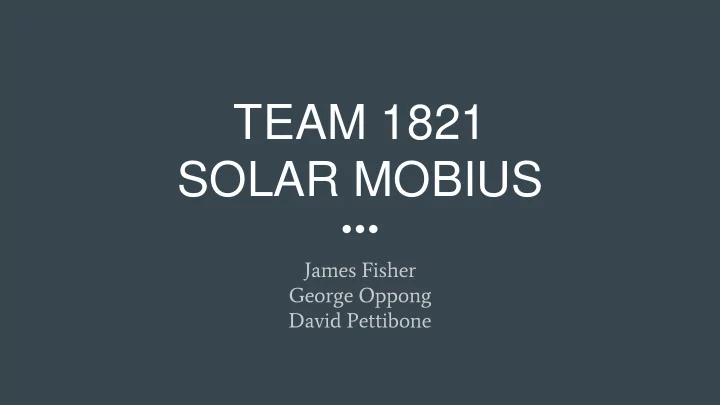

TEAM 1821 SOLAR MOBIUS James Fisher George Oppong David Pettibone
Background ● Designed by Robert Perless in 1995 ● Located in front of Castleman Building ● Base is made of stainless steel with five polycarbonate prisms mounted on a stepper motor Mobius Solaris
Project Objective Task One • Design a fully functioning solar tracker in order to obtain the angle of the sun • Experimentally determine when, and at what angle of the statue, it is possible to reflect a rainbow onto Castleman • Rotate the statue at appropriate times to the correct angle to display the rainbow, as often as possible throughout the day Task Two • Create a basic website that will provide general information about the solar tracker and statue itself
System
Light Sensor One opaque plate ● separating two equivalent photoresistors and two static resistors Mounted to a stepper ● motor and rotated to acquire angle of the sun The Raspberry Pi reads ● the voltage levels to determine which direction it needs to turn the stepper motor The sensor will be placed ● in an acrylic dome shielding it from the weather and wind.
Solar Tracker Design Composed of Raspberry Pi controller, driver, a small stepper motor and our light ● sensor. Obtains angle of the sun which will correspond to an angle the statue needs to be to ● put a rainbow on the building. Experimentation results gave us the corresponding angles between the motor for the ● Mobius and the motor attached to the light sensor. This circuit will be outside covered by an acrylic dome to protect from weather & ● wind.
Mobius Experiment Goal: Create a lookup table of angles and corresponding times of when a rainbow can feasibly be projected onto Castleman. Steps: 1. Set the resolution of the Mobius stepper motor to be 8000 steps per revolution. 2. Set up reference (starting) point to be East before beginning experiment. 3. Spin the statue at a fast rate of 40 hz 4. Wait and watch for a rainbow to be on the building 5. Mark down the time when a rainbow is on the building. 6. Calculate the angle of the statue since it was being pulsed at constant frequency. 7. Use solar tracker to get the angle of the sun at the opportune times of a rainbow.
Test Results We found that the rainbow can only be placed onto the front of the building in ● the morning at a few particular angles In the afternoon the angle of the sun to the statue only allows for the rainbow to ● reflect onto the far right side of the building It was determined experimentally that it is only possible to maintain a rainbow on ● the front of the building for periods of time between about 9am and noon.
Software Reads the sensor’s voltage readings through the ADC and pulses the sensor ● stepper motor accordingly, keeping count of each pulse sent to the motor Pulses the statue’s stepper motor to designated angles based on the count read ● from the sensor’s stepper motor. On boot up makes sure that both motors are at reference with the use of a bright ● LED, magnet and reed switch. Detects night time/cloudy days, and returns both motors to reference after ● calculating the shortest path. Periodically updates a website with the current orientation of both stepper ● motors.
Website UITS assigned static IP to our ● Raspberry Pi’s MAC address for Uconn Guest Website periodically updates the ● count of the two stepper motors every 5 seconds, representing the angles of the motors.
PCB
Demo Circuit
Complications The driver used in our design to power the stepper motors was not ideal in ● hindsight Resistance seen through the potentiometer is too small to sufficiently limit the current to the ○ motor Motor still runs, but overheats very quickly due to this current ○ Implementation of our design into the Mobius was setback by this ● overheating issue, as well as frequent inclement weather throughout the past few weeks PCB that we designed did not function as intended, we soldered our design to ● vector boards to compensate.
Conclusions Our design is functional and performs as expected in a laboratory setting, and ● would have been implemented barring the issues with heat dissipation A new driver should be selected for our design - preferably one that could have a ● higher resistance than the model we chose An interconnect for the various devices used in the form of a PCB could condense ● our design further
Questions?
Recommend
More recommend